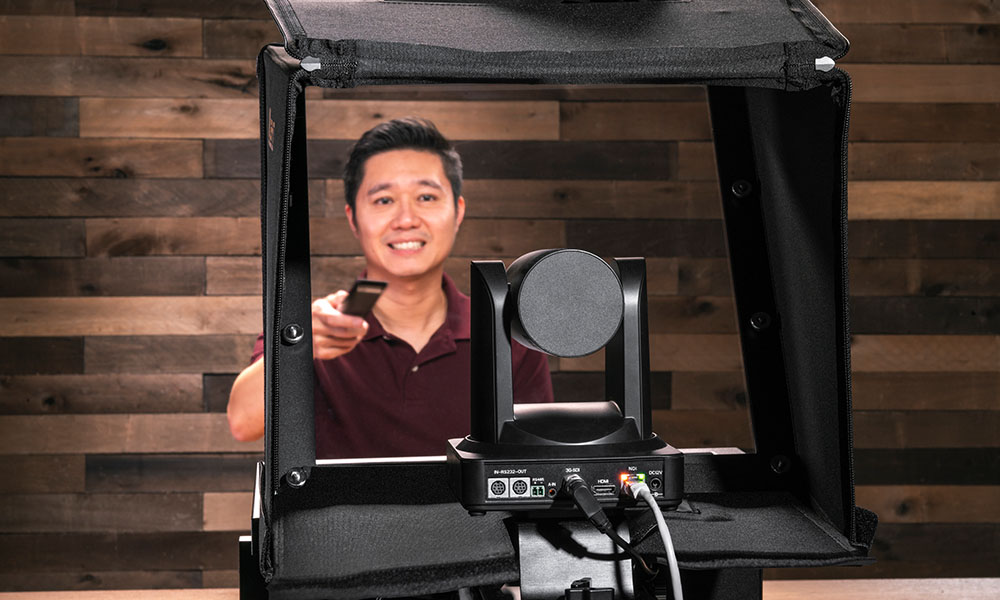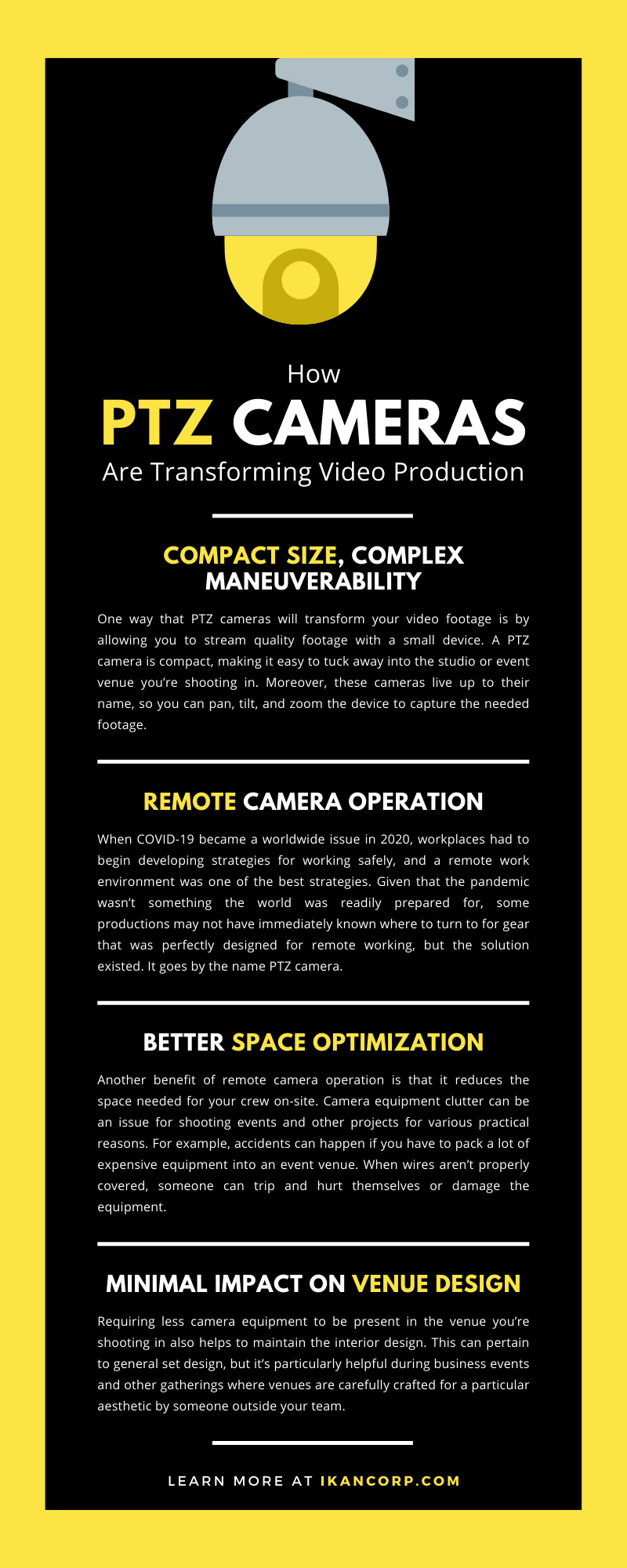 If you want to expand your video production capabilities, you must know what the other hardware on the market is capable of because there are so many options available. Plus, there are so many video production niches, so it can be challenging to pinpoint the best solution for your specific situation. For instance, if your current camera model is working fine, then why would you consider working with PTZ cameras? How niche or broad are its applications?
If you want to expand your video production capabilities, you must know what the other hardware on the market is capable of because there are so many options available. Plus, there are so many video production niches, so it can be challenging to pinpoint the best solution for your specific situation. For instance, if your current camera model is working fine, then why would you consider working with PTZ cameras? How niche or broad are its applications?
The acronym PTZ details the device’s functionality—pan, tilt, and zoom. A PTZ camera may seem like a compact security camera, but it can do much more for you when filming live events, broadcasts, and beyond. This comprehensive guide will provide a clearer look at how PTZ cameras are transforming video production and how they can transform your set for your next shoot. Read below to find out why and how you can start improving your productions with a surprisingly small piece of equipment.
Compact Size, Complex Maneuverability
One way that PTZ cameras will transform your video footage is by allowing you to stream quality footage with a small device. A PTZ camera is compact, making it easy to tuck away into the studio or event venue you’re shooting in. Moreover, these cameras live up to their name, so you can pan, tilt, and zoom the device to capture the needed footage.
Although the device is small, they have powerful enough zooming capabilities to support professional production needs. This means you can place the PTZ camera in many different spots in your shooting space to get the ideal shot—no more moving around bulky cameras when shooting footage.
Thanks to the various ways you can maneuver a PTZ camera, the necessity for moving the entire camera mostly comes down to your filming preferences. Bigger cameras can certainly be the perfect tool in many circumstances, but that’s what makes the video camera market so intriguing—you can find professional-grade devices for many shooting preferences.
Plus, a PTZ camera can attach to more places than a nearby flat surface or a tripod because wall and ceiling mounts expand your camera placement opportunities even more. Having more ways to get coverage means having more solutions available if you’re original shooting plan goes awry. Wall and ceiling mounts are fantastic, and tripods are a suitable way to use PTZ cameras if that’s what your production calls for—maneuverability is just one of the diverse design characteristics of these devices.
Remote Camera Operation
When COVID-19 became a worldwide issue in 2020, workplaces had to begin developing strategies for working safely, and a remote work environment was one of the best strategies. However, for any industry, including video production, to work remotely, they need equipment designed to work under such conditions. Given that the pandemic wasn’t something the world was readily prepared for, some productions may not have immediately known where to turn to for gear that was perfectly designed for remote working, but the solution existed. It goes by the name PTZ camera.
You can find PTZ cameras at Ikan that come with controllers for wireless operation. This means your camera operator doesn’t need to be hands-on with the camera to make any adjustments unless they need to pick it up and move it to a new area entirely. Moreover, teaming PTZ cameras up with an IP network makes the perfect pairing for remote work environments.
With the help of an Ethernet cable and a reliable IP network, you can pair video devices remotely without experiencing a significant drop in quality. In addition to assisting with safety guidelines, the remote operation of PTZ cameras helps productions shoot in locations otherwise difficult to reach with other hardware, opening your creative opportunities further.
Better Space Optimization
Another benefit of remote camera operation is that it reduces the space needed for your crew on-site. Camera equipment clutter can be an issue for shooting events and other projects for various practical reasons. For example, accidents can happen if you have to pack a lot of expensive equipment into an event venue.
When wires aren’t properly covered, someone can trip and hurt themselves or damage the equipment. Likewise, someone bumping into a camera can have similar results. Luckily, you can reduce the amount of equipment you need on-site, thus reducing the potential for the accidents mentioned earlier to happen.
Of course, PTZ cameras still require responsible installation to keep people and equipment safe. That said, you can spend less time stressing over the perfect setup when you have powerful but compact equipment like a PTZ camera. Space optimization also affects the footage you can capture. The less space your equipment takes up in your shooting location, the more coverage you can work with, making it easier to film everything you need.
Minimal Impact on Venue Design
Requiring less camera equipment to be present in the venue you’re shooting in also helps to maintain the interior design. This can pertain to general set design, but it’s particularly helpful during business events and other gatherings where venues are carefully crafted for a particular aesthetic by someone outside your team.
Suffice it to say that a bunch of video equipment residing in the venue can distract or cover up the venue’s beauty. Thus, when you have PTZ cameras in your inventory, you can hide those cameras in the best shooting locations and seamlessly integrate them into their surroundings. This also plays into your shooting coverage because when video equipment isn’t covering up beautiful venue spots, you can use that beauty to elevate your footage.
Thanks to this closer look at how PTZ cameras are transforming video production, you can explore ways to use this tech to transform any production. It’s not often that you have a piece of video production equipment that excels at shooting broadcast footage and events but can also act as a reliable security surveillance camera. The titular camera device is a diverse addition to the industry, so don’t hesitate to add it to your inventory when the situation calls for it.

